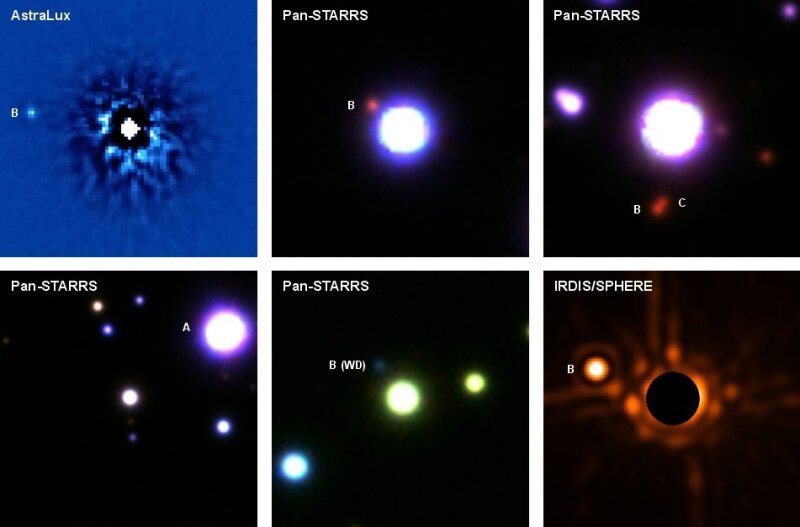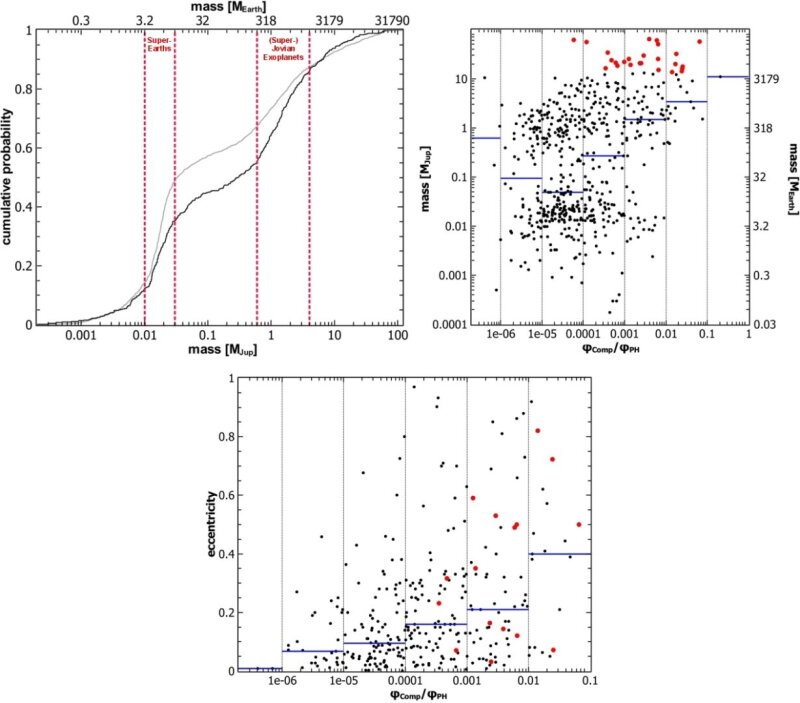Multiplicity Study of Exoplanet Host Stars
Exo Planets Hosts
Image: Markus MugrauerAbstract:
A key aspect in the diversity of exoplanets is the multiplicity of their host stars.
As described by theories stellar companions of exoplanet host stars can significantly influence the formation process of planets around these stars as well as the long-term evolution of their orbits. On the one hand, in close binary systems, planet formation and long-term stable orbits of planets are restricted to the close vicinity (only a few astronomical units) around the host stars. On the other hand, in wide binary systems, the orbital evolution of the star system itself, for example under the influence of galactic tides or perturbations from other passing stars, can significantly affect the orbits of exoplanets around their host stars.
How planets form and evolve in multiple star systems is a very important question in modern astrophysics, since a large fraction of the stars in our galaxy are members of binary or even higher order multiple star systems. Furthermore, the efficiency of planet formation in these systems also affects the total number of planets in the Milky Way.
In order to detect such stellar systems with exoplanets, we have initiated several surveys to search for stellar companions of exoplanet host stars, using either seeing-limited, lucky-, or high-contrast adaptive optics imaging, as well as data releases of the European Space Agency (ESA) Gaia mission. With these different surveys, we are able to cover the entire detection space for possible stellar companions around the exoplanet host stars and can thus accurately determine the multiplicity rate of these stars, and characterize the properties of their companions. Eventually, our efforts will allow us to determine the true impact of stellar multiplicity on planet formation and evolution
The team
Principle Investigator:
- Markus Mugrauer (AIU Jena)
Team Members:
- Christian Adam (Centro de Astronomía de la Universidad de Antofagasta)
- Matilde Fernández Hernández (IAA-CSIC)
- Christian Ginski (U Galway, Irland)
- Kai-Uwe Michel (AIU Jena)
- Ralph Neuhäuser (AIU Jena)
- Lara Pietsch (AIU Jena)
Former Team Members:
- Lara Dürrenberg
- Saskia Schlagenhauf
- Ann-Kathrin Kollak
- Nikolaus Vogt
- Sven Buder
- Therese Heyne
- Tsevi Mazeh
- Friedemann Reum
- Tristan Röll
- Johanna Rück
- Martin Seeliger
- Andreas Seifahrt
- Jule Zander
Our current Projects
- Long-term Multiplicity Survey of northern Exoplanet host Stars with the Lucky-Imager AstraLux at CAHA/2.2m (started in 2008)
→ for results see publications - Long-term Multiplicity Survey of southern Exoplanet host Stars using the extreme Adaptive Optics SPHERE/VLT (started in 2016)
→ for results see publications - Multiplicity Study of Exoplanet Hosts using Data of the ESA-Gaia mission (started in 2018)
→ for results see publications & VizieR catalogues of detected companions (Link1External link, Link2External link, Link3External link) - ESA-Gaia Search for stellar companions of TESS Objects of Interest (started in 2020)
→ for results see publications & VizieR catalogues of detected companions (Link1External link, Link2External link, Link3External link, Link4External link) & Our online image libraryExternal link of detected companions
Our Publications
- Mugrauer, M., Michel, K.-U., Dürrenberg, L., Kollak, A.-K., Rück, J., Zander, J. (2024) "ESA-Gaia Multiplicity Study of TESS Objects of Interest" eas conf, 716
- Mugrauer, M., Michel, K.-U., Schlagenhauf, S., Ginski, C. (2024) "The impact of stellar multiplicity on the formation and evolution of planets" eas conf, 715
- Schlagenhauf, S., Mugrauer, M., Ginski, C., Buder, S. Fernández, M., Bischoff, R. (2024) "Search for stellar companions of exoplanet host stars with AstraLux/CAHA 2.2 mExternal link" MNRAS 529, 4768
- Michel, K.-U. & Mugrauer, M. (2024) "Gaia search for (sub)stellar companions of exoplanet hostsExternal link" MNRAS 527, 318
- Mugrauer, M., Rück, J., & Michel, K.-U. (2023) "Gaia Search for stellar Companions of TESS Objects of Interest IVExternal link" AN 343, 30055
- Mugrauer, M., Zander, J., & Michel, K.-U. (2022) "Gaia Search for stellar Companions of TESS Objects of Interest IIIExternal link" AN 343, 24017
- Mugrauer, M., Schlagenhauf, S., Buder, S., Ginski, C., Fernández, M. (2022) "Follow-up observations of the binary system γ CepExternal link" AN 343, 24014
- Mugrauer, M., & Michel, K.-U. (2021) "Gaia search for stellar companions of TESS Objects of Interest IIExternal link" AN 342, 840
- Michel, K.-U., & Mugrauer, M. (2021) "Search for (sub)stellar companions of exoplanet hosts by exploring the second ESA-Gaia data releaseExternal link" FrASS 8, 14
- Mugrauer, M., & Michel, K.-U. (2020) "Gaia search for stellar companions of TESS Objects of InterestExternal link" AN 341, 996
- Ginski, C., Mugrauer, M., Adam, C., et al. (2020) "How many suns are in the sky? A SPHERE multiplicity survey of exoplanet host stars I -- Four new close stellar companions including a white dwarfExternal link" A&A 649, 156
- Mugrauer, M., Ginski, C., Vogt, N., et al. (2020) "How many suns are in the sky? Multiplicity surveys of exoplanet host starsExternal link" IAUS 345, 316
- Mugrauer, M. (2019) "Search for stellar companions of exoplanet host stars by exploring the second ESA-Gaia data releaseExternal link" MNRAS 490, 5088
- Mugrauer, M., Ginski, C., Vogt, N., et al. (2018) "Search for (Sub)Stellar Companions of Exoplanet Host StarsExternal link" dmss.conf, 21
- Cagigal, M. P., Valle, P. J., Cagigas, M. A., et al. (2017) "Covariance of lucky images: performance analysisExternal link" MNRAS 464, 680
- Mugrauer, M., Buder, S., Reum, F., et al. (2017) "The Großschwabhausen binary surveyExternal link" AN 338, 61
- Mugrauer, M., & Dinçel, B. (2016) "Follow-up spectroscopic observations of HD 107148 B: A new white dwarf companion of an exoplanet host starExternal link" AN 337, 627
- Ginski, C., Mugrauer, M., Seeliger, M., et al. (2016) "A lucky imaging multiplicity study of exoplanet host stars - IIExternal link" MNRAS 457, 2173
- Mugrauer, M., & Ginski, C. (2015) "High-contrast imaging search for stellar and substellar companions of exoplanet host starsExternal link" MNRAS 450, 3127
- Mugrauer, M., Ginski, C., & Seeliger, M. (2014) "New wide stellar companions of exoplanet host starsExternal link" MNRAS 439, 1063
- Ginski, C., Mugrauer, M., & Neuhäuser, R. (2014) "Lucky imaging multiplicity studies of exoplanet host starsExternal link" CoSka 43, 410
- Ginski, C., Mugrauer, M., Seeliger, M., et al. (2013) "The multiplicity status of three exoplanet host starsExternal link" A&A 559, A71
- Roell, T., Neuhäuser, R., Seifahrt, A., et al. (2012) "Extrasolar planets in stellar multiple systemsExternal link" A&A 542, A92
- Ginski, C., Mugrauer, M., Seeliger, M., et al. (2012) "A lucky imaging multiplicity study of exoplanet host starsExternal link" MNRAS 421, 2498
- Mugrauer, M., Neuhäuser, R., Ginski, C., et al. (2010) "Multiplicity study of exoplanet host starsExternal link" HiA 15, 694
- Mugrauer, M., & Neuhäuser, R. (2009) "The multiplicity of exoplanet host stars. New low-mass stellar companions of the exoplanet host stars HD 125612 and HD 212301External link" A&A 494, 373
- Jang-Condell, H., Mugrauer, M., & Schmidt, T. (2008) "Disk Truncation and Planet Formation in γ CepheiExternal link" ApJL 683, L191
- Neuhäuser, R., Mugrauer, M., Seifahrt, A., et al. (2008) "Astrometric and photometric monitoring of GQ Lupi and its sub-stellar companionExternal link" A&A 484, 281
- Mugrauer, M., Seifahrt, A., Neuhäuser, R., et al. (2007) "Multiplicity Study of Exoplanet Host Stars: the HD 3651 AB SystemExternal link" IAUS 240, 638
- Mugrauer, M., Neuhaeuser, R., Mazeh, T., et al. (2007) "Multiplicity study of Exoplanet host StarsExternal link" IAUS 240, 329
- Neuhäuser, R., Seifahrt, A., Röll, T., et al. (2007) "Detectability of Planets in Wide Binaries by Ground-Based Relative Astrometry with AOExternal link" IAUS 240, 261
- Mugrauer, M., Seifahrt, A., & Neuhäuser, R. (2007) "The multiplicity of planet host stars - new low-mass companions to planet host starsExternal link" MNRAS 378, 1328
- Mugrauer, M., Neuhäuser, R., & Mazeh, T. (2007) "Spectroscopic confirmation of the companions GJ 3021 B and HD 27442 B, one new planet host triple-star system, and global statisticsExternal link" A&A 469, 755
- Seifahrt, A., Neuhäuser, R., & Hauschildt, P. H. (2007) "Near-infrared integral-field spectroscopy of the companion to GQ LupiExternal link" A&A 463, 309
- Neuhäuser, R., Mugrauer, M., Fukagawa, M., et al. (2007) "Direct detection of exoplanet host star companion γ Cep B and revised masses for both stars and the sub-stellar objectExternal link" A&A 462, 777
- Mugrauer, M., Seifahrt, A., Neuhäuser, R., et al. (2006) "HD3651B: the first directly imaged brown dwarf companion of an exoplanet host starExternal link" MNRAS 373, L31
- Mugrauer, M., Neuhäuser, R., Mazeh, T., et al. (2006) "A search for wide visual companions of exoplanet host stars: The Calar Alto SurveyExternal link" AN 327, 321
- Mugrauer, M., & Neuhäuser, R. (2005) "GQ Lup and its common proper motion companionExternal link" AN 326, 701
- Mugrauer, M., Neuhäuser, R., Seifahrt, A., et al. (2005) "Four new wide binaries among exoplanet host starsExternal link" A&A 440, 1051
- Mugrauer, M., Neuhaeuser, R., Guenther, E., et al. (2005) "The multiplicity of exoplanet host starsExternal link" AN 326, 629
- Mugrauer, M., & Neuhäuser, R. (2005) "Gl86B: a white dwarf orbits an exoplanet host starExternal link" MNRAS 361, L15
- Neuhäuser, R., Guenther, E. W., Wuchterl, G., et al. (2005) "Evidence for a co-moving sub-stellar companion of GQ LupExternal link" A&A 435, L13
- Mugrauer, M., Neuhäuser, R., Guenther, E., et al. (2005) "Multiplicity of Exoplanet Hosts Stars" prpl.conf, 8026
- Mugrauer, M., Neuhäuser, R., Mazeh, T., et al. (2004) "A Direct Imaging Search for Wide (Sub)Stellar Companions around Rad-vel Planet Host StarsExternal link" ASPC 321, 127
- Mugrauer, M., Neuhäuser, R., Mazeh, T., et al. (2004) "Astrometric confirmation of a wide low-mass companion to the planet host star HD 89744External link" AN 325, 718
- Mugrauer, M., Neuhäuser, R., Mazeh, T., et al. (2004) "A low-mass stellar companion of the planet host star HD 75289External link" A&A 425, 249
- Mugrauer, M., Neuhäuser, R., Mazeh, T., et al. (2004) "A Search for Wide (Sub)Stellar Companions Around Extrasolar Planet Host StarsExternal link" AIPC 713, 31
Recent Student Thesis Work
- Pietsch, L. (2024) "Suche und Charakterisierung stellarer Begleiter von (C)TOIs"
- Dürrenberg, L. (2023) "Suche und Charakterisierung stellarer Begleiter von KOIs"
- Kollak, A.-K. (2022) "Suche nach stellaren Begleitern von (C)TOIs"
- Rück, J. (2022) "Suche nach stellaren Begleitern potentieller Planeten-Muttersterne"
- Schlagenhauf, S. (2022) "AstraLux Lucky-Imaging Observations of Exoplanet host Stars"
- Michel, K.-U. (2021) "Search for (sub)stellar Companions of Exoplanet Hosts by using Data from the ESA-Gaia mission"
- Zander, J. (2021) "ESA-Gaia Search for stellar Companions of TESS Objects of Interest"
Press Releases
- FSU Jena press release 01/2024: "Extrasolar worlds between several suns"
- Calar Alto press release 01/2007: "Double sun sunset no longer science fictionExternal link"
- ESO press release 10/2006: "The star, the dwarf and the planetExternal link"
- FSU Jena press release 07/2005: "Wie ein Planet zwischen zwei Sonnen entsteht und überlebtExternal link"


